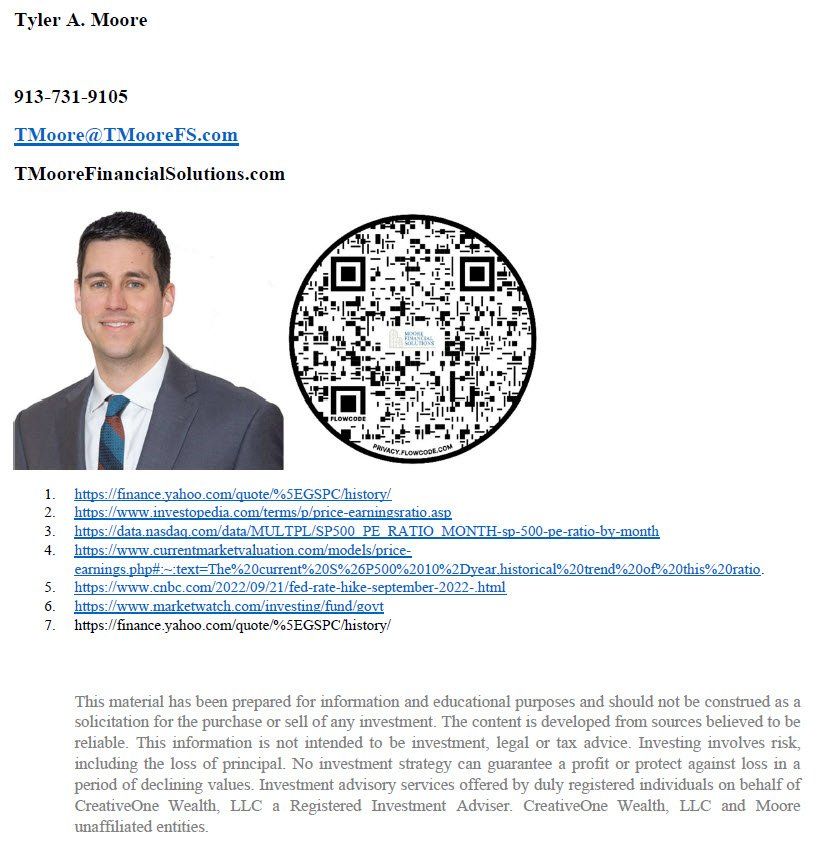The third quarter of 2022 saw a further decrease in equity prices, as investors wrestled with the
thought of an impending recession. We believe the primary topic leading to equity selling continues to be policy action by the Federal Reserve to reduce inflation. The S&P 500 fell another 6.27% in Q3, continuing a trend of losing quarters for 2022 (1). This movement in equity prices may likely challenge the willingness to hold tight in down markets, but we remind Moore Financial Solutions clients of the patience required when investing in equities. This quarterly review will highlight strategies in down market cycles, P/E ratios of equities, and include a review of Federal Reserve Policy changes made in Q3 of 2022.
Our clients find financial stability in periods of higher equity (stock) prices and often find themselves more willing to use funds for travel or planned home renovation, for example. By contrast, lower equity prices often create a commitment to be more disciplined with an investment plan. We encourage our clients to contribute (or increase contributions) to their investment accounts in these lower market cycles to prepare for a potential recovery in equities. 2022 has forced Moore F.S. to quickly change from a high equity price strategy to a sudden bear market strategy. Generally, this includes rebalancing into equities when appropriate, as well as an overall increased willingness to create new equity positions while markets are low. For many clients, we are looking to convert pretax money into post-tax accounts, when appropriate. Furthermore, we aim to increase allocations to small cap equities when appropriate. It is our opinion that small cap equities will rebound more sharply than large and medium sized companies. Our small cap strategy can only partially be put to work as we remain cautious of the impact higher interest rates can have on small companies who often operate on a more leveraged (debt heavy) balance sheet.
A top goal of Moore F.S. continues to be the education of investing principles. This quarter we highlight changes for 2022 in the P/E Ratios. Most likely you haven’t heard of P/E Ratios, but their simple structure can give equity investors a detailed look into market cycles. First off, what is a P/E ratio? A P/E ratio measures a stock’s current price, divided by its earnings per share (2). For example, AT&T’s current price per share of $15.56, divided by its annual earnings per share of $2.71, equates to a P/E ratio of approximately 5.74. In other words, when investors buy AT&T, they could assume it would take 5.74 years to recoup their $15.56. We use P/E ratios to gauge where the market is in terms of overbought or oversold. To begin the year, the S&P 500 had a forward-looking P/E ratio of 23.11 (3). Investors were purchasing the S&P 500 with the understanding that based on the current rate of earnings they are offering up 23.11 years of earnings to make the purchase. By contrast, the current (September 30th, 2022) P/E ratio of the S&P 500 is 18.12. In the opinion of Moore F.S., P/E ratios are a simple tool to evaluate investor sentiment towards equities and determine what level of risk pertains to investing in equities. This gauge is not perfect and does not determine the direction of equities. When the S&P 500 is near a 23.11 P/E ratio, we determine investors are more willing to accept paying a higher price for equities for a variety of factors. For example, the real return on bond fund yields (after inflation) being less than exciting. The average modern era P/E ratio of the S&P 500 is 19.6, while the average P/E ratio of the last ten years is 26.6 (4). We sense investors continued to buy stocks when the P/E ratio was above its average in expectation that earnings would increase. Furthermore, we forecast a gradual move back to a 20 P/E over the course of 18-24 months. In talking with clients, we have stated that we are increasing our exposure to equities, especially for younger, risk tolerant clients. We continue to believe that by looking at a variety of factors, including the drop in P/E ratio below the average, stocks offer an ideal entry point. It is certainly possible stocks could fall more before a recovery occurs. With equities more favorable now than to begin the year (in terms of P/E ratios) we remain optimistic. We believe equities will rebound to a more average P/E ratio, and we remain hopeful the earnings associated with equities will continue to increase, and ultimately not see a recession. In the most basic form, when you buy stocks, you are paying up front for future earnings. It is important to remember that in the short term, equities can be volatile, but historically they offer a very sound opportunity to create wealth and according to P/E ratios, potentially now more so than to begin the year.
The Federal Reserve offered policy changes during Q3 of 2022, as many predicted. On September 21, 2022, the Federal Reserve increased benchmark interest rates by .75%, representing another large and meaningful move. This increase took the Fed funds rate range to 3-3.25%. This represents the most aggressive Fed tightening since the Federal Reserve began using the overnight funds rate as its primary policy tool in 1990. In 1994 the Fed hiked a total of 2.25 percentage points. We later found out the Fed would begin cutting rates by July of the following year (5). We believe Federal Reserve Chairman Jerome Powell has surprised very few with this large rate increase. Moore F.S. sold all positions of iShares U.S. Treasury Bond ETF (GOVT) on July 14th, 2022, in preparation for the increases of rates. In cases that are appropriate for clients, we anticipate moving back into this and other bond positions in the 4th quarter of 2022. The iShares U.S. Treasury Bond ETF continued to move approximately 4.6% lower between July 14th and the end of Q3 (6). Bonds tend to offer an inverse movement with interest rates, as interest rates go up the value of bond funds go down. This downward movement in the value of bond funds as interest rates have risen, continues to negatively impact portfolios that hold bonds. Though we are not predicting the Fed to repeat their pattern of reducing rates the year following rate increases (as we mentioned above) this action would be a tailwind for bond funds in 2023, thus we aim to layer back into bond funds.
The challenge of volatile equity markets remains an emotional experience. I urge my clients to always respect the power of what stock markets really are, an emotional willingness to put money to work into companies that offer long-term growth. Without going into too great of detail, we live in an environment where algorithms move stock markets and can move markets very quickly. In my opinion, this gives way to environments where the S&P 500 can move up 13.7% in the first half of the quarter (June 30th closing price of 3,785.38 to August 16th closing price of 4,305.20 (7)) and suddenly make a 50% recovery for the year. I can assume that somewhere out there an investor decided on June 30th they have had enough of the market downturn and decided to move to a money market account, only to miss out on the next approximately 45 days. 45 days later (lets assume) that same guy or gal had a bad case of “fear of missing out” and reinvested into equities, only to experience the move lower over the next half of a quarter. Of course, this is purely hypothetical, but I use this example to remind you that my job is not only to act as a fiduciary, but also to keep us grounded in our plan. In many cases we must use equities in your plan to be able to hit long-term growth goals. Otherwise, we will see your purchasing power be eroded significantly by inflation. I don’t know when the bear market will be over, and I don’t want to begin to make that prediction. Rather, I’d like to voice my continued commitment to buying and holding for the long term. I believe you and I continue to make a great team and we will weather this storm, and likely many more in the future.






